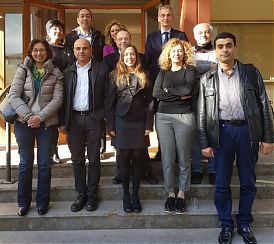SICILY AND TUNISIA, MEETING ABOUT LEISHMANIASIS


Sicily is the historically oldest region for cases of leishmaniasis. The first manifestations of the disease on the island date back to the early 1900s.
In recent years, leishmaniasis has spread throughout the country and even in areas where it was previously non-existent, now there are several cases of the disease.
In the period 2013-2014 there has been a peak of human visceral leishmaniasis that has affected the hilly and pedestrian areas of the provinces of Reggio Emilia, Modena and especially Bologna, probably due to an increase in the density of the carrier caused in turn by particular climatic aspects environmental.
In Sicily leishmaniasis is constantly present over time. In the province of Palermo and Agrigento, this year there have been two cases of visceral leishmaniasis (the most dangerous, which can invade organs in particular the spleen and may even be fatal) and several cases of cutaneous leishmaniasis that produces an ulcer to epidermal level.
These are some of the data that emerged during the training event “The Leishmaniasis basin: new Insights into the Epidemiology of a Neglected Disease” which ended at the Istituto Zooprofilattico of Sicily.
Leishmaniasis is a complex disease, transmissible to humans by the bite of infected insects, the phlebotomist, which grows in damp and shady places, occupied by organic debris (undergrowth foliage, dens of small mammals, manure, heaps of stones and cracks of dry walls). They are the females that sting the host because they need to feed themselves with blood for the maturation of the eggs: they act more often at twilight, pricking the smooth areas of the skin, and they feed on the blood coming out of the wound.
Cutaneous leishmaniasis affect all age groups, especially males, adolescents and young adults, while visceral ones affect children, who are often in contact with tank dogs, but also non-immune or immunosuppressed adults.
Most infections are inapparent and often resolve spontaneously. Only a small part of cases evolve towards the full-blown form. Factors that favor evolution are genetic and also affect age, malnutrition, immunosuppression.
Leishmaniasis arrives in Sicily from the hottest countries, particularly from Tunisia. In the North African state, the leishmania mayor is very widespread, producing lepers and having as its animal the rodent. Since Sicily is a cross-border region, concerns emerge that the mayor may enter Sicily. At the moment, in Sicily, no case has been registered.
(ITALPRESS/MNA).
Source: medNews

